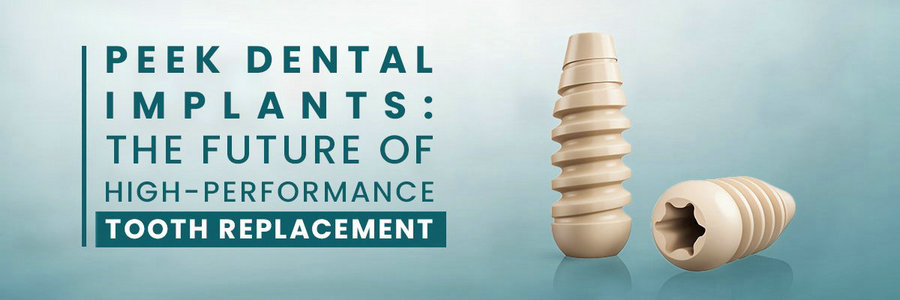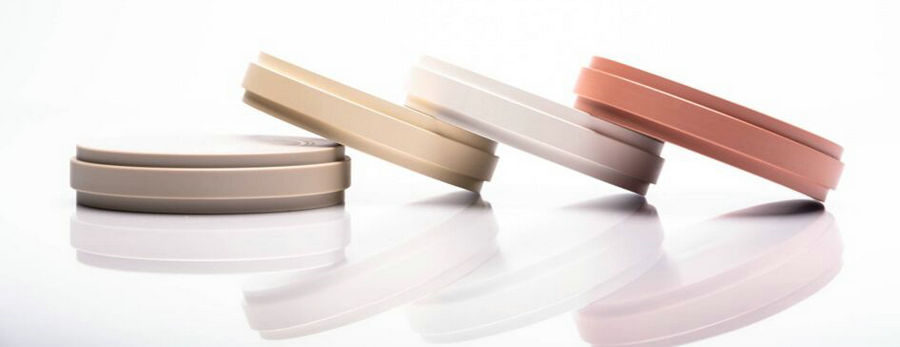
Polyether Ether Ketone (PEEK) is a high-performance polymer known for its excellent biocompatibility, corrosion resistance, light weight, and non-toxic properties. Notably, PEEK’s elastic modulus is closer to that of human cortical bone and dentin. In orthopedics, PEEK has been designated as the optimal bone graft material and has received approval from the U.S. FDA.
In recent years, its application in the dental field has garnered attention from scholars both domestically and internationally. Research and application of PEEK as implants and temporary abutments are gradually increasing. This article aims to review the basic properties of PEEK materials, their current research progress in dental implant applications, and to forecast their clinical application prospects.
1. Biological Characteristics of PEEK Material
PEEK is a member of the polyaryl ether ketone (PAEK) family. It has an aromatic molecular structure composed of aromatic rings linked by ketone and ether functional groups, making it a semi-crystalline, linear thermoplastic polymer. This chemical structure endows the material with stability at high temperatures (above 300°C), high mechanical strength, low wear rate, and chemical resistance. Additionally, PEEK is highly resistant to gamma rays and electron beams, while also being radiolucent, meaning it does not produce artifacts in X-rays and does not affect MRI imaging.
PEEK has reliable biocompatibility, with lower bacterial adhesion on its surface compared to pure titanium, and it poses no side effects to the human body. However, as an inert material, PEEK has relatively low surface bioactivity and weak interactions with surrounding tissues, which limits its practical applications. Therefore, enhancing PEEK’s surface properties and optimizing its bioactivity has become a research focus. Current methods include surface modification techniques such as sandblasting, plasma etching, amination, calcium phosphate coatings, and titanium coatings to stimulate PEEK’s bioactivity.
2. Application of PEEK in Dental Implants
1. PEEK Implants
Currently, dental implants used clinically are primarily made from titanium, its alloys, and zirconia. Titanium has excellent biocompatibility and osseointegration properties. However, the elastic modulus of titanium implants does not match that of the alveolar bone. Titanium’s higher elastic modulus compared to bone leads to stress concentration on the implant, resulting in stress shielding, reduced bone loading, and eventual bone resorption.
Moreover, mandibular X-ray imaging used to assess pathological conditions can be affected by scattering radiation around the implant, potentially reducing image quality and impacting diagnosis. Although titanium sensitivity cases are rare, they have been reported in up to 0.6% of cases, which drives the development of alternative implant materials.
Compared to titanium, PEEK has several clinical advantages as an implant material:
First, PEEK rarely causes allergic reactions.
Second, PEEK's beige or gray color provides better aesthetic results as it lacks metallic appearance.
Third, PEEK's elastic modulus is closer to that of cortical and cancellous bone, reducing stress shielding after implantation.
Fourth, PEEK is a versatile base material with good biocompatibility when in contact with soft tissues, aiding in gingival tissue healing and shaping.
Fifth, PEEK's high chemical stability ensures it does not shed debris or cause ion leakage over long-term use in tissues, reducing the risk of biological corrosion. Therefore, some studies suggest replacing titanium with PEEK as a dental implant material.
Several factors influence implant stability, including occlusal load, bone quality and quantity, peri-implantitis, and marginal bone resorption.
2. PEEK Abutments
Compared to titanium or zirconia abutments, PEEK abutments are easier to modify due to their good mechanical properties. Temporary PEEK abutments are closer in color to dentin, providing better aesthetic outcomes when creating temporary abutments. Custom PEEK healing abutments require fewer restorative steps during the surgical phase to achieve the desired gingival contour, compared to standard healing caps.

3. PEEK Central Screws
Among implant restoration complications, central screw fractures are quite common. While traditional titanium is strong, it is prone to wear and can be difficult to remove once fractured. PEEK, with an elastic modulus closer to that of cortical bone and dentin, offers high wear resistance and easier retrieval after fracture. Due to these performance characteristics, some scholars suggest that PEEK central screws may be more suitable for clinical use. In an in vitro comparison, Cantarella et al. found that PEEK central screws had lower fracture resistance than titanium screws. Saravi et al. observed that PEEK central screws tend to fracture at the screw neck, making them easier to remove.
4. PEEK 3D Printing
Most dental implants are made from titanium or titanium alloys. However, these implants are prefabricated and significantly differ from the natural root morphology. 3D printing technology for polymers has replaced complex metal 3D printing techniques, allowing for the design of patient-specific implants that closely resemble the natural tooth root, resulting in more biomimetic polymer dental implants.
However, more evidence is needed to determine the mechanical properties and accuracy of 3D-printed PEEK implants compared to metal alternatives. One major drawback of PEEK implants is their biological inertness, which poses a significant challenge to osseointegration and long-term fixation in vivo. Therefore, efforts should focus on developing bioactive PEEK-based dental implants. PEEK exhibits properties suitable for various implant components in dentistry, including temporary and long-term restorations. While PEEK offers good aesthetics and mechanical properties similar to human bone, it also faces risks of fracture and wear. To broaden PEEK’s application in dentistry, further modification is necessary. Continued research on PEEK implants is essential to potentially replace titanium for long-term use in the future.

FAQ about detal PEEK.
What is PEEK used for in dentistry?
PEEK could be used as a bone alternative for dental implants, osteosynthesis plates, cranial implants, and reconstructions of the nose, maxilla, and mandible.
What is a PEEK denture?
PEEK is a medical grade polymer that provides patients with an alternative solution to chrome cobalt dentures. PEEK has a high strength to weight ratio and is available in a natural, non-contrasting colour, meaning it looks more natural in the patient's mouth.
What is PEEK dental implants?
PEEK is a high-performance material known for its high resilience and strength. Its tooth-colored appearance further enhances its appeal for aesthetic applications.
How much do PEEK dentures cost?
Flexible PEEK Partial Denture - £1000.
How to clean PEEK dentures?
Brush your dentures at least daily.
What are PEEK dentures made of?
PEEK dentures are a non metal or metal free alternative to acrylic & chrome dentures. Made from Polyetheretherketone, which has excellent biocompatibility and bone-like properties. Peek is high grade polymer often used in other medical procedures like skull replacement & hip replacements.
What is PEEK in dentistry?
PEEK is an easy dental material to integrate into the oral cavity, as its color can be modified during processing. Even full dentures can be fabricated to appear natural, ensuring patients can speak, smile and eat with confidence.
What are PEEK partial dentures made of?
It is a semicrystalline thermoplastic material. PEEK has an excellent chemical resistance and mechanical properties that are retained at high temperatures.